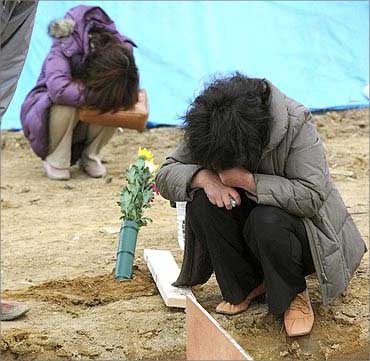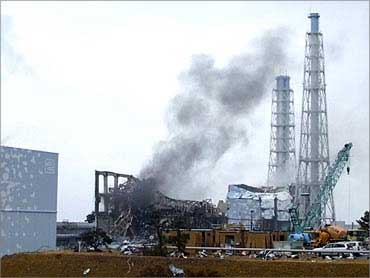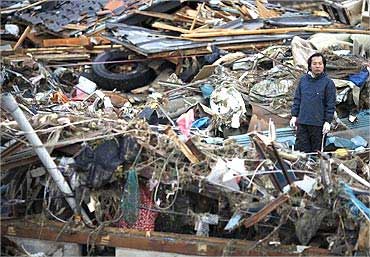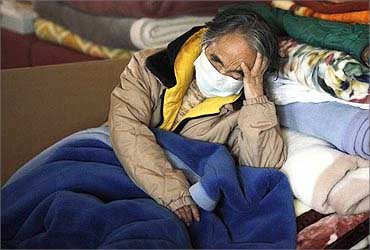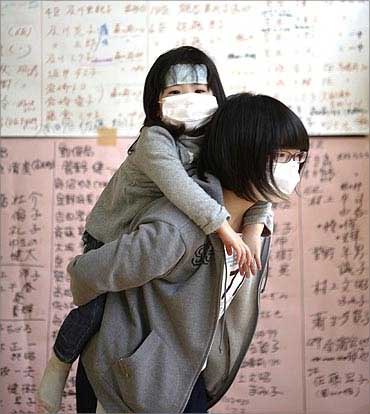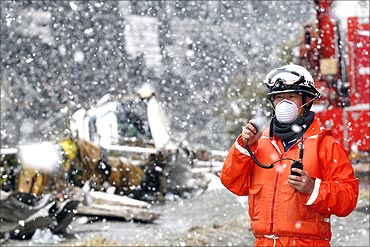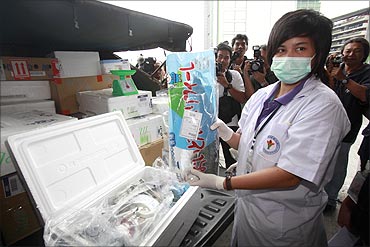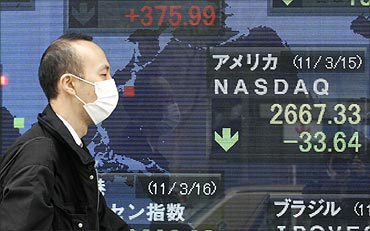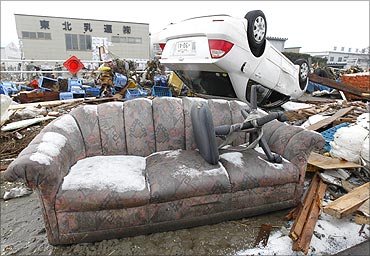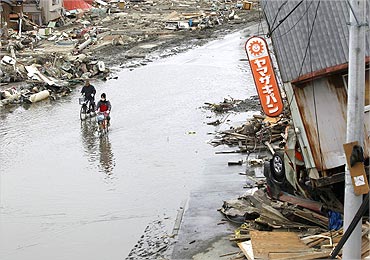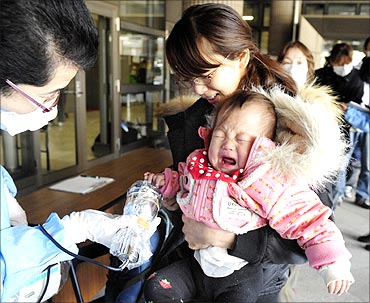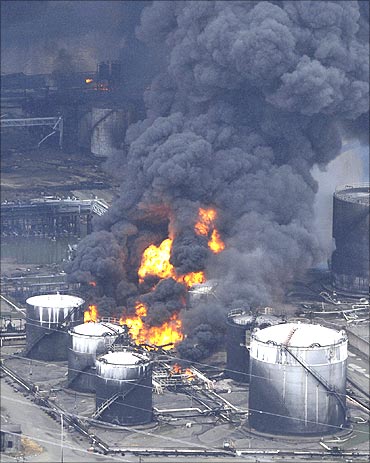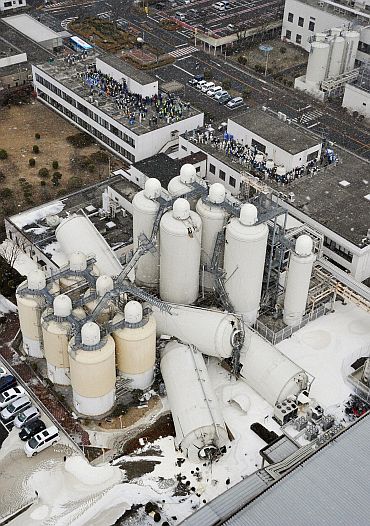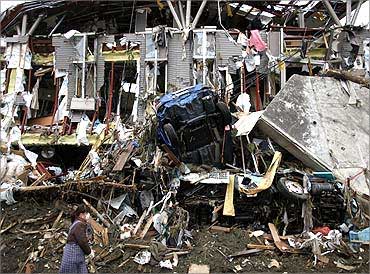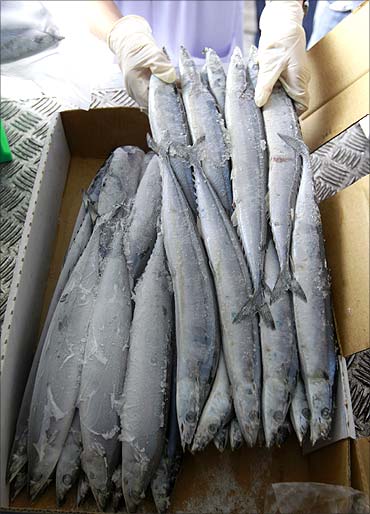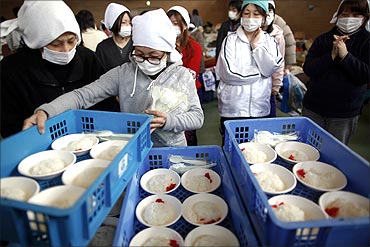25 facts on Japan's $300 billion disaster
Last updated on: March 24, 2011 14:16 IST
The world's third largest economy is still reeling under one of the worst crises ever. Japan is estimated to suffer a crippling loss of over $200-300 billion, according to Risk Management Solutions Inc.
"Given that the immediate priorities in Japan are likely to be social not economic, the aftershocks to the global economies from this disaster may unfold very slowly; many of the economic consequences have yet to be seen. A multinational company whose supply chain could be impacted by the catastrophe should start now by assuming that its business is severely disrupted for an extended period and develop an effective mitigation strategy, Sanjay Kedia, country head and CEO Marsh India said.
Click
NEXT to read on...
25 facts on Japan's $300 billion disaster
Last updated on: March 24, 2011 14:16 IST
The World Bank, in its latest East Asia and Pacific Economic update, has said that the earthquake and tsunami could result in an economic loss of up to $235 billion, or four per cent of its gross domestic product (GDP).
Click NEXT to read on . . .
25 facts on Japan's $300 billion disaster
Last updated on: March 24, 2011 14:16 IST
Citigroup expects 5-10 trillion yen ($62-125 billion) loss to housing and infrastructure. The devastation at the nuclear power plants alone is likely to $5 billion.
Click NEXT to read on
25 facts on Japan's $300 billion disaster
Last updated on: March 24, 2011 14:16 IST
According to Barclays, the total cost of the earthquake will be $152-217 billion.
Click NEXT to read on . . .
25 facts on Japan's $300 billion disaster
Last updated on: March 24, 2011 14:16 IST
Mitsubishi UFJ Securities and Sarasin expect the loss to be as high as 5 per cent of the nation's GDP.
Most of the supply chain disruption from this catastrophe is likely to be caused by issues associated with infrastructure, energy, utilities, transportation, and restrictions on highway/port access, according to Marsh India, insurance broker and risk advisor.
Click NEXT to read on . . .
25 facts on Japan's $300 billion disaster
Last updated on: March 24, 2011 14:16 IST
The World Bank report states it would take about five years to rebuild Japan. The economy could slip into a recession.
Click NEXT to read on . . .
25 facts on Japan's $300 billion disaster
Last updated on: March 24, 2011 14:16 IST
The Kobe earthquake in 1995 is estimated to have cost $115-118 billion, or 2 per cent of GDP. After the Kobe earthquake, Japan's trade with Asian economies has fallen substantially.
Click NEXT to read on . . .
25 facts on Japan's $300 billion disaster
Last updated on: March 24, 2011 14:16 IST
Being the hub of global semiconductor industry, the production shutdown in Japan has affected the global supply chain.
Electronics giants Hitachi and Sony have been worst hit. Apple, which banks on Japan for key components for its best selling products -- iPad 2 and iPhone 4 -- will be severely hit. The delay in restarting full production could stretch till end of June 2011.
Click NEXT to read on . . .
25 facts on Japan's $300 billion disaster
Last updated on: March 24, 2011 14:16 IST
Several refineries in Japan have stopped operations. The tourism industry in Japan and other nations will be badly affected.
Click NEXT to read on . . .
25 facts on Japan's $300 billion disaster
Last updated on: March 24, 2011 14:16 IST
Japan's automobile sector has been forced to shut down production for the time being. Nissan, Toyota, Honda have suffered losses of $24.7 million per day, according to
The Business Insider. Click NEXT to read on . . .
25 facts on Japan's $300 billion disaster
Last updated on: March 24, 2011 14:16 IST
Several petrochemical plants and facilities in Japan have stopped production. This time around, disruption to production networks, especially in automotive and electronics industries, could continue to pose problems beyond one year, the World Bank report said.
Click NEXT to read on . . .
25 facts on Japan's $300 billion disaster
Last updated on: March 24, 2011 14:16 IST
Japan's Economy Minister Kaoru Yosano said the losses from the earthquake could be over $250 billion.
Click NEXT to read on . . .
25 facts on Japan's $300 billion disaster
Last updated on: March 24, 2011 14:16 IST
The World Bank report notes that after the 1995 Kobe earthquake, Japan's trade had slowed only for a few months, with imports recovering fully within a year and exports rebounding to 85 per cent of pre-quake levels in the same period.
Click NEXT to read on . . .
25 facts on Japan's $300 billion disaster
Last updated on: March 24, 2011 14:16 IST
Goldman Sachs expects total economic losses to hit 16 trillion yen, while it expects real GDP to decline by 0.5-2 per cent in the second quarter.
Click NEXT to read on . . .
25 facts on Japan's $300 billion disaster
Last updated on: March 24, 2011 14:16 IST
According to Mitsubishi UFJ Securities, Japan's debt could reach 2-10 per cent of total gross domestic product (GDP), which is now pegged at $ 4.3 billion.
Click NEXT to read on . . .
25 facts on Japan's $300 billion disaster
Last updated on: March 24, 2011 14:16 IST
Insured losses from Japan's earthquake could be as high as $35 billion. Reinsurance firms, like PartnerRE, EverestRE, and RenaissanceRe have exposures to the country.
Aflac has 80 per cent of its earnings exposed to the Japanese market, according to
The Business Insider.
Click NEXT to read on . . .
25 facts on Japan's $300 billion disaster
Last updated on: March 24, 2011 14:16 IST
The earthquake and tsunami were a complex, 'super cat' event, RMS said, adding that it led to multiple crises like power disruption and decommissioning of several nuclear power stations. There is a widespread concern about potential crop contamination.
Click NEXT to read on . . .
25 facts on Japan's $300 billion disaster
Last updated on: March 24, 2011 14:16 IST
Japan lost 50 per cent of its GDP in the 1923 earthquake. Japan's public debt is now double the size of its $5 trillion output.
Click NEXT to read on . . .
25 facts on Japan's $300 billion disaster
Last updated on: March 24, 2011 14:16 IST
Fukushima prefecture accounts for 1.5 per cent of Japan's GDP. The prefecture is responsible for 2.5 per cent of agriculture/fishery and 2.0 per cent of manufacturing.
Among manufacturing, electrical machinery (3.4%) and precision machinery (5.1%) have relatively bigger shares of their respective industries' national output, according to
The Business Insider.
Click NEXT to read on . . .
25 facts on Japan's $300 billion disaster
Last updated on: March 24, 2011 14:16 IST
The earthquake has resulted in a huge power crisis. Around 216,164 houses in north Japan were without electricity.
At least 760,000 households in 10 prefectures were without running water At least 760,000 households in 10 prefectures were without running water.
Click NEXT to read on . . .
25 facts on Japan's $300 billion disaster
Last updated on: March 24, 2011 14:16 IST
Toyota has stalled production in 12 assembly plants in Japan and faces a production loss of 140,000 vehicles. It will also delay the launch of the Prius hybrid minivan in Japan.
Click NEXT to read on . . .
25 facts on Japan's $300 billion disaster
Last updated on: March 24, 2011 14:16 IST
The government will infuse public money into banks to help support lending for companies. Bank of Japan will increase in the bank's asset buying scheme, ramped up to $123 billion.
Click NEXT to read on . . .
25 facts on Japan's $300 billion disaster
Last updated on: March 24, 2011 14:16 IST
The Japanese government is working on plans to provide low interest loans of up to $122 billion to help companies recover from the crisis.
Click NEXT to read on . . .
25 facts on Japan's $300 billion disaster
Last updated on: March 24, 2011 14:16 IST
The most significant initial impact will be to the hi-tech, steel and auto industries quickly followed by those that depend on these industries such as medical devices, communications gear suppliers, car dealerships, solar, ship building, aviation and consumer electronics, says Marsh India.
Click NEXT to read on . . .
25 facts on Japan's $300 billion disaster
Last updated on: March 24, 2011 14:16 IST
Private insurance firms would only be liable for a small proportion of the cost of rebuilding, leaving households and the government to pay for the bulk of it, the World Bank said.


